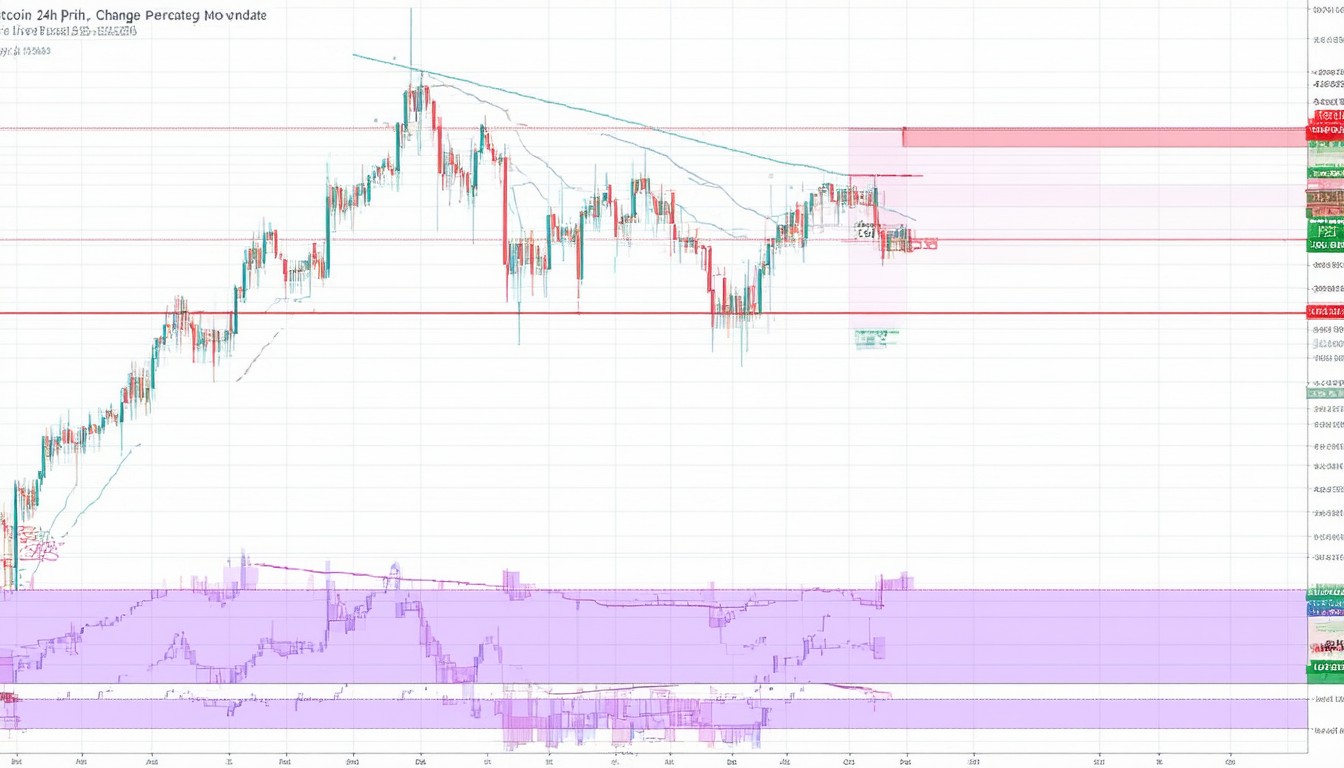In the volatile world of digital assets, few indicators attract as much attention as Bitcoin’s 24-hour price change. As the benchmark for the cryptocurrency market, Bitcoin’s day-over-day movement serves as a rapid barometer of market sentiment, investor behavior, and broader macroeconomic influences. Whether Bitcoin surges or plummets, its 24h change number is often cited by traders, analysts, and media alike—shaping perceptions and informing both short-term decisions and long-range strategies.
What Does Bitcoin’s 24h Change Mean?
Bitcoin’s 24h change measures the percentage increase or decrease in the coin’s market price over the previous 24 hours. This metric answers a fundamental question on any trading platform: how much has Bitcoin’s price shifted in the past day? It’s a dynamic figure, typically expressed as a percentage alongside the absolute dollar change, recalculated minute by minute on major exchanges.
For investors, the 24-hour change is more than just a fleeting statistic—it offers crucial context. It can unveil trend reversals, signal potential volatility, and act as an early indicator for shifts that often ripple through other digital assets. On platforms like Binance, Coinbase, and Kraken, the 24h change is featured prominently, testifying to its significance for both new and experienced traders.
Why the 24h Window?
The 24-hour timeframe has become standard in crypto largely due to the market’s non-stop nature. Unlike traditional equities exchanges, cryptocurrency trading occurs round-the-clock, powered by a global network of users and nodes. This never-closing aspect means there’s no daily open or close; every minute, new information flows in, and every hour, market conditions can shift.
“In the realm of cryptocurrencies, the 24-hour price change isn’t just a statistic—it’s the marketplace’s heartbeat, visible in real time,” explains Dr. Simone Rossi, financial analyst and blockchain researcher.
Factors Driving Bitcoin’s 24h Price Movement
Bitcoin’s price is rarely stable for long. Its 24h change reflects a complex interplay of factors, each with the potential to trigger significant upswings or sharp corrections.
1. Market Sentiment and News Cycles
Sentiment—fueled by everything from regulatory announcements to celebrity tweets—remains a powerful catalyst. For example, in 2021, Bitcoin experienced double-digit 24h shifts following high-profile statements from influential figures or surprise government interventions.
- Positive catalysts: Adoption news (e.g., El Salvador declaring Bitcoin legal tender), institutional investments, or major platform integrations.
- Negative catalysts: Regulatory crackdowns, security breaches, or significant downtimes on exchanges.
2. Trading Volume and Liquidity Dynamics
Trading volume speaks to the intensity of market participation. During periods of high activity, price changes can accelerate, particularly if liquidity (the ability to buy and sell without notable price impact) is thin. Events like “liquidity crunches”—when many traders rush to buy or sell at once—often result in exaggerated 24h swings.
3. Broader Economic Trends
Beyond crypto-specific events, macroeconomic trends such as inflation data, interest rate decisions, and geopolitical instability all feed into Bitcoin’s 24h change. In recent years, some investors have viewed BTC as a hedge against inflation or currency devaluation, though this narrative isn’t universally accepted.
4. Technical and Algorithmic Trading
An increasing share of Bitcoin trading volume now comes from bots and automated strategies that exploit price inefficiencies. When price triggers are hit—whether in stop-loss orders, margin calls, or algorithmic arbitrage—large, rapid movements can occur, sometimes amplifying the 24h change.
Real-World Examples of Significant 24h Changes
Bitcoin’s history is punctuated by dramatic one-day moves, each with its own context and consequences for the broader crypto ecosystem.
- March 2020 Crash: Triggered by the onset of global COVID-19 fears and a flight to liquidity, Bitcoin’s price declined by over 40% in a single 24-hour span, marking one of its steepest-ever drops.
- Elon Musk’s Tweets (2021): A single tweet highlighting Tesla’s acceptance, and later withdrawal, of Bitcoin payments resulted in immediate, double-digit percent swings within hours.
- ETF Approval News (2023): Announcements or speculation about Bitcoin spot ETF approvals have been met with rapid surges or pullbacks, with the 24h change reflecting investor exuberance—or disappointment.
Each event illustrates how singular developments can translate directly into pronounced intraday volatility, underscoring the importance of monitoring 24h change figures.
How to Track and Interpret Bitcoin’s 24h Change
Reliable Data Sources
Most reputable cryptocurrency exchanges provide live updates on Bitcoin’s 24h change, including price charts, volume stats, and historical comparisons. Third-party aggregators like CoinMarketCap, CoinGecko, and Messari also compute and display accurate, real-time 24-hour changes.
Key points when tracking:
- Check multiple sources: Disparities can exist between providers due to data refresh lags or exchange-specific quirks.
- Understand reference points: Some platforms reset their 24-hour window at different times or use varied calculation methodologies.
Interpreting the Numbers: Not All Changes Are Created Equal
A +10% move is certainly eye-catching—but context matters. A jump following thin overnight trading may have very different implications than the same rise on huge volume after major news. It’s crucial to combine 24h change analysis with:
- Volume data: Are large moves happening on heavy trading or light, illiquid markets?
- News context: Is a price shift explained by known events, or is it more mysterious?
- Longer timeframes: Short-term volatility may not always align with long-term trends.
Beyond this, experienced traders may look to related indicators such as Relative Strength Index (RSI) or moving averages to validate whether a sharp 24h move likely signals a broader trend shift.
The Impact of Bitcoin’s 24h Change on the Broader Crypto Market
As crypto’s flagship asset, Bitcoin’s movements often cascade into the altcoin universe. A large positive 24h change in BTC frequently boosts overall market confidence and can spark “alt season” rallies among lesser-known coins. Conversely, a sharp downturn in Bitcoin’s price can trigger broader sell-offs, reflecting the coin’s outsized role in the digital asset ecosystem.

For institutional investors, the 24h change often guides risk management decisions—prompting rebalancing, increased hedging, or, at times, temporary exits from high-volatility assets.
A Feedback Loop
The 24h change isn’t just a reflection of market action but also a driver of it. Media coverage about large BTC moves can create a self-reinforcing cycle: news drives new activity, which then feeds back into further price movement.
“The real power of Bitcoin’s 24-hour change is psychological—it’s a signal to the market that something meaningful is happening, sparking curiosity and sometimes fear or greed,” observes crypto strategist Lara Mohanty. “That’s why it’s watched so closely by traders and journalists alike.”
Best Practices for Crypto Investors Responding to 24h Change
While the allure of rapid gains brings many newcomers to the market, reliance on the 24h change statistic alone can be risky. Savvy investors keep several principles in mind:
- Avoid knee-jerk reactions: Reacting to large 24-hour swings without broader context can lock in losses or miss impending reversals.
- Prioritize risk management: Set stop-losses and only allocate funds that fit your risk profile.
- Diversify: While Bitcoin often leads, diversification across assets can mitigate single-asset volatility.
- Stay informed: Monitor not just price, but market news, regulatory developments, and cross-market correlations.
In practice, integrating 24h change data into a larger, holistic market analysis process is the hallmark of seasoned traders.
Conclusion: Navigating Bitcoin’s 24h Change in a 24/7 Market
Bitcoin’s 24-hour price change is both a mirror and a motor for broader market sentiment. It’s an essential tool—used by day-traders, institutions, and observers—to gauge and react to the fast-evolving world of cryptocurrencies. Yet, as with all real-time statistics, its true value lies in intelligent interpretation: considering context, corroborating with additional data, and staying aware of both hype and risk.
For anyone watching Bitcoin’s pulse, the 24h change is indispensable. But as with all investing, a steady hand, informed judgment, and a clear understanding of market drivers remain fundamental.
FAQs
What is Bitcoin’s 24h change and why is it important?
Bitcoin’s 24h change measures the percentage rise or fall in price over the previous 24 hours, reflecting immediate market sentiment and volatility. It helps traders and investors assess short-term momentum and make timely decisions.
How do I find live Bitcoin 24h change data?
Most major exchanges and cryptocurrency data platforms display current 24h price change statistics. Reliable aggregators like CoinMarketCap, CoinGecko, and leading trading platforms update this metric in real time.
Can Bitcoin’s 24h change predict future price trends?
While dramatic 24h moves may hint at shifting trends, this metric alone doesn’t guarantee future direction. It’s best interpreted in conjunction with other indicators, volume data, and news analysis.
Why do 24h changes vary slightly across platforms?
Differences in calculation methods, time-zone cutoffs, and exchange-specific data feeds can create small discrepancies. Always check a few sources for a clear overall picture.
How should investors react to large 24-hour swings?
Rather than overreacting, it’s wise to use 24h changes as one input among many, combining them with broader analysis to avoid impulsive trading. Effective risk management and diversification are prudent responses to volatility.







Leave a comment